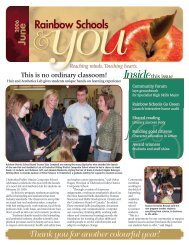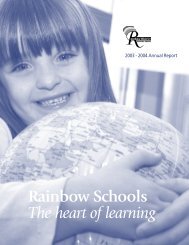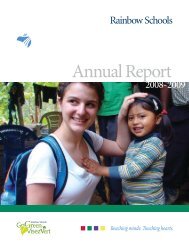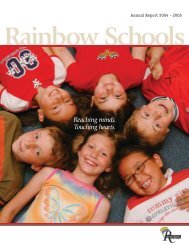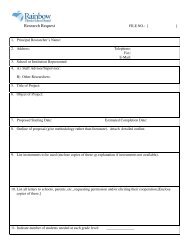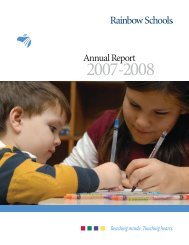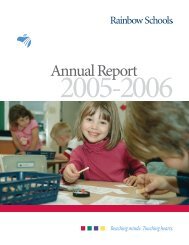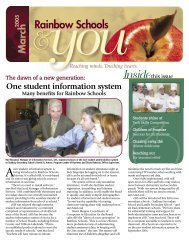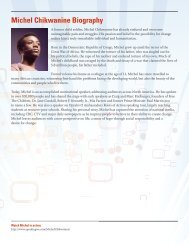Transition Guide - Rainbow District School Board
Transition Guide - Rainbow District School Board
Transition Guide - Rainbow District School Board
Create successful ePaper yourself
Turn your PDF publications into a flip-book with our unique Google optimized e-Paper software.
How do I know<br />
if my child is at risk?<br />
Definition of “at risk’’<br />
According to the Ministry of Education, the following students may be considered<br />
at risk of not being successful in their courses, which significantly reduces their<br />
chances of graduating:<br />
• Elementary students who are<br />
performing at level 1 or below<br />
grade expectation.<br />
• Secondary students who are<br />
performing significantly below the<br />
provincial standard, earning marks<br />
in the 50s or low 60s, and who do not<br />
have the foundations to be successful<br />
in the new curriculum.<br />
Did you know?<br />
• Students who fail one course in Grade 9<br />
significantly decrease their chances of graduating.<br />
• Students who miss three or more days a month<br />
are considered at risk of not being successful.<br />
• Students who are disengaged<br />
from classes for a variety of reasons,<br />
which tend to be reflected in<br />
poor attendance.<br />
• Students who are skipping classes.<br />
• Students who are performing poorly<br />
on assessments.<br />
How schools<br />
can help students<br />
Secondary schools have a variety<br />
of programs and resources available<br />
to students to ensure their success:<br />
• Homework clubs that take place at lunch<br />
and/or after school<br />
• Homework websites posted by individual<br />
teachers for students to access daily homework<br />
assignments and due dates<br />
• Peer helper programs<br />
• Additional one-on-one assistance<br />
from classroom teachers<br />
• Summer <strong>School</strong> programs<br />
• Credit Recovery programs<br />
• Student Success Teacher support<br />
• Guidance Counsellor support<br />
• Attendance Counsellor support<br />
• Social Workers<br />
What parents need to know…<br />
Find out what is available to you and your child to ensure success in secondary school.<br />
Six ways to succeed:<br />
1. Co-operative Education -<br />
The Co-operative Education<br />
Program integrates classroom<br />
theory with practical experience.<br />
Students divide their time between<br />
the school and the workplace.<br />
2. Ontario Youth Apprenticeship<br />
Program (OYAP) - This Co-operative<br />
Education Program gives senior<br />
students an opportunity to begin<br />
a career in a skilled trade while<br />
attending high school.<br />
3. Dual Credit Programs -<br />
Students can earn credits that can<br />
be applied towards both their<br />
secondary school diploma and their<br />
postsecondary diploma, degree or<br />
apprenticeship certification.<br />
4. Specialist High Skills Major<br />
(SHSM) - The Specialist High Skills<br />
Major (SHSM) is a specialized,<br />
Ministry of Education approved<br />
program that allows students to<br />
focus their learning on a specific<br />
economic sector while meeting<br />
the requirements of the Ontario<br />
Secondary <strong>School</strong> Diploma (OSSD).<br />
SHSMs assist students in their<br />
transition from secondary school<br />
to apprenticeship training, college,<br />
university or the workplace.<br />
5. Student Success Teams -<br />
Each secondary school has a<br />
dedicated team that supports<br />
students to ensure they earn the<br />
credits they need to graduate.<br />
<strong>Rainbow</strong> <strong>School</strong>s are committed to ongoing communication with parents/guardians regarding student progress.<br />
<strong>Rainbow</strong> <strong>School</strong>s | Reaching minds. Touching hearts.<br />
6. Grade 8 to Grade 9 <strong>Transition</strong> -<br />
Elementary and secondary teachers<br />
work together to ease the transition,<br />
through special information nights for<br />
students/parents, transition activities<br />
in secondary schools, more dialogue<br />
between teachers in both panels,<br />
increased professional learning to<br />
share best practices and improved<br />
tracking of students and their progress.<br />
7



